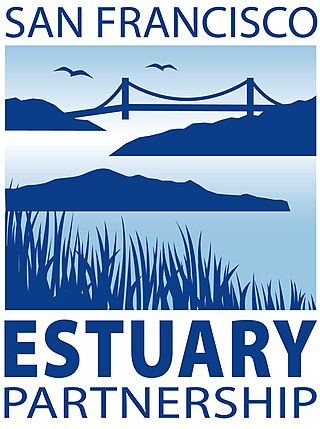Related Research Articles

Environmental protection is the practice of protecting the natural environment by individuals, groups and governments. Its objectives are to conserve natural resources and the existing natural environment and, where it is possible, to repair damage and reverse trends.

The Coastal Zone Management Act of 1972 is an Act of Congress passed in 1972 to encourage coastal states to develop and implement coastal zone management plans (CZMPs). This act was established as a United States National policy to preserve, protect, develop, and where possible, restore or enhance, the resources of the Nation's coastal zone for this and succeeding generations.
Adaptive management, also known as adaptive resource management or adaptive environmental assessment and management, is a structured, iterative process of robust decision making in the face of uncertainty, with an aim to reducing uncertainty over time via system monitoring. In this way, decision making simultaneously meets one or more resource management objectives and, either passively or actively, accrues information needed to improve future management. Adaptive management is a tool which should be used not only to change a system, but also to learn about the system. Because adaptive management is based on a learning process, it improves long-run management outcomes. The challenge in using the adaptive management approach lies in finding the correct balance between gaining knowledge to improve management in the future and achieving the best short-term outcome based on current knowledge. This approach has more recently been employed in implementing international development programs.

Environmental planning is the process of facilitating decision making to carry out land development with the consideration given to the natural environment, social, political, economic and governance factors and provides a holistic framework to achieve sustainable outcomes. A major goal of environmental planning is to create sustainable communities, which aim to conserve and protect undeveloped land.

The Korea Forest Service is a central administrative agency under the Ministry of Agriculture, Food and Rural Affairs (MAFR), responsible for protecting and nurturing forests, increasing forest resources, developing forest products, conducting research on forest management and improvement, and is located in Daejeon Government Complex. In the past, during the national forestation campaign from 1973 to 1986, it was temporarily under the Ministry of Home Affairs, but returned to the Ministry of Agriculture, Forestry and Fisheries in 1987. However, as the agency's work was focused solely on maintaining and managing successful national forestation policies, questions were raised about its necessity for a period of time. Currently, the agency has transformed its identity into one that strives to generate continuous income through forest resources.
The Pennsylvania Department of Environmental Protection (DEP) is the agency in the U.S. state of Pennsylvania responsible for protecting and preserving the land, air, water, and public health through enforcement of the state's environmental laws. It was created by Act 18 of 1995, which split the Department of Environmental Resources into the Department of Environmental Protection and the Department of Conservation and Natural Resources. Its current secretary is Rich Negrin.

The Florida Department of Environmental Protection (FDEP) is the Florida government agency responsible for environmental protection.
The Water Resources Development Act of 1986 is part of Pub. L.Tooltip Public Law 99–662, a series of acts enacted by Congress of the United States on November 17, 1986.
The Water Resources Development Act of 1999, Pub. L.Tooltip Public Law 106–53 (text)(PDF), was enacted by Congress of the United States on August 17, 1999. Most of the provisions of WRDA 1999 are administered by the United States Army Corps of Engineers.
The Water Resources Development Act of 2000, Pub. L.Tooltip Public Law 106–541 (text)(PDF), was enacted by Congress of the United States on December 11, 2000. Most of the provisions of WRDA 2000 are administered by the United States Army Corps of Engineers.
The National Park Service underwent an intensive review of its responsibilities and prospects for the future during its 75th anniversary celebration in 1991. It culminated its efforts in October 1991 with a symposium in Vail, Colo. that including several hundred participants from both within and outside the NPS. The gathering, the Oct. 10, 1991 session of which was officially a public meeting advertised in the Federal Register of Sept. 19, 1991, resulted in six strategic objectives and the identification of a variety of issues and recommendations, which were published in a book titled National Parks for the 21st Century: The Vail Agenda. Although the meeting took place during the administration of Secretary of the Interior Manuel Lujan and NPS Director James Ridenour, with the book itself published under the leadership of Secretary Bruce Babbitt and Director Roger Kennedy, who wrote the foreword and preface, the Vail agenda and vision remains today as a directional tool for the NPS.
Citizens Campaign for the Environment (CCE) was founded in 1985 by a small group of Long Island citizens. CCE is as a not-for-profit organization. Offices are in Farmingdale, White Plains, Albany, Syracuse and Buffalo in New York and in Hamden, Connecticut. CCE has 120,000 members and is a non-partisan environmental advocacy organization classified as a 501(c)4 non-profit organization.

The Susquehanna River Basin Commission (SRBC) is a federal-interstate compact commission created by the Susquehanna River Basin Compact (Pub. L. 91-575) between three U.S. states: (Pennsylvania, New York, and Maryland), and the federal government, and signed into law by President Richard Nixon on Christmas Eve 1970 to be effective 30 days later on January 23, 1971.

"No net loss" is the United States government's overall policy goal regarding wetlands preservation. The goal of the policy is to balance wetland loss due to economic development with wetlands reclamation, mitigation, and restorations efforts, so that the total acreage of wetlands in the country does not decrease, but remains constant or increases. To achieve the objective of no net loss, the federal government utilizes several different environmental policy tools which legally protect wetlands, provide rules and regulations for citizens and corporations interacting with wetlands, and incentives for the preservation and conservation of wetlands. Given the public benefits provided by wetland ecosystem services, such as flood control, nutrient farming, habitat, water filtration, and recreational area, the estimations that over half the acreage of wetlands in the United States has been lost within the last three centuries is of great concern to local, state, and federal agencies as well as the public interest they serve.

The Division of Water Resources within the Kansas Department of Agriculture governs the use and allocation of the state's water resources; regulates the construction of dams, levees and other changes to streams; represents Kansas on its four interstate river compacts; and coordinates the National Flood Insurance Program in Kansas. These responsibilities are accomplished through the administration of 30 state laws, including the Kansas Water Appropriation Act, Groundwater Management District Act, Obstructions in Streams, and the Levee Law.
Soil governance refers to the policies, strategies, and the processes of decision-making employed by nation states and local governments regarding the use of soil. Globally, governance of the soil has been limited to an agricultural perspective due to increased food insecurity from the most populated regions on earth. The Global Soil Partnership, GSP, was initiated by the Food and Agriculture Organization (FAO) and its members with the hope to improve governance of the limited soil resources of the planet in order to guarantee healthy and productive soils for a food-secure world, as well as support other essential ecosystem services.

The San Francisco Estuary Partnership (Partnership) is one of the 28 National Estuary Programs created in the 1987 Amendments to the Clean Water Act. The Partnership is a non-regulatory federal-state-local collaboration working to restore water quality and manage the natural resources of the San Francisco Bay-Sacramento–San Joaquin River Delta estuary. The Partnership works with over 100 municipalities, non-profits, governmental agencies, and businesses and helps develop, find funding for, and implement over 40 projects and programs aimed at improving the health of the estuary. The partnership either directly implements these projects, or administers and manages grants, holds educational workshops and highlights project results. The Partnership is also the official representative for the San Francisco Bay region to the Most Beautiful Bays in the World.

The California Water Plan is the State of California’s long-term strategic plan for managing and developing water resources throughout the state. The Water Plan is mandated by California Water Code Sections 10004–10013, and the California Department of Water Resources (DWR) is required to update the plan every five years. Although the Water Plan does not create mandates, propose specific projects, or authorize funding, Water Code Section 10005 defines the plan and its updates as “the master plan which guides the orderly and coordinated control, protection, conservation, development, management and efficient utilization of the water resources of the state.” Eleven updates to the plan have been prepared since 1957.

Conservation banking is an environmental market-based method designed to offset adverse effects, generally, to species of concern, are threatened, or endangered and protected under the United States Endangered Species Act (ESA) through the creation of conservation banks. Conservation banking can be viewed as a method of mitigation that allows permitting agencies to target various natural resources typically of value or concern, and it is generally contemplated as a protection technique to be implemented before the valued resource or species will need to be mitigated. The ESA prohibits the "taking" of fish and wildlife species which are officially listed as endangered or threatened in their populations. However, under section 7(a)(2) for Federal Agencies, and under section 10(a) for private parties, a take may be permissible for unavoidable impacts if there are conservation mitigation measures for the affected species or habitat. Purchasing “credits” through a conservation bank is one such mitigation measure to remedy the loss.

Climate change adaptation in the Philippines is being incorporated into development plans and policies that specifically target national and local climate vulnerabilities. As a developing country and an archipelago, the Philippines is particularly vulnerable to a variety of climatic threats like intensifying tropical cyclones, drastic changes in rainfall patterns, rising sea levels, and rising temperatures. According to the UN Office for the Coordination of Humanitarian Affairs (OCHA), the Philippines is one of the most disaster-prone countries in the world. In 2021, the Global Climate Risk Index ranked the Philippines fourth of the ten countries most affected between the years 2000 and 2019. The need for managing climate risks through climate change adaptation has become increasingly evident. Adaptation can reduce, moderate or avoid current and expected climate effects or take advantage of beneficial climatic events. Developing greater resilience to various threats can be a major goal of comprehensive disaster risk reduction strategy. The Philippines is therefore working on a number of national and local adaptation and disaster risk reduction strategies to build the country's climate resilience.
References
- 1 2 McDonald, Bill; Cech, Tom (2012). "Defend and Develop: Why the Colorado Water Conservation Board Was Developed" (PDF). Archived from the original (PDF) on 2014-10-22. Retrieved 2016-02-17.
- ↑ "Colorado Water Conservation Board".
- ↑ About Us | Colorado Water Conservation Board Archived 2014-10-21 at the Wayback Machine
- ↑ Defend and Develop: A Brief History of the Colorado Water Conservation Board’s First 75 Years Archived 2014-10-22 at the Wayback Machine
- ↑ Colorado Water Plan finalized. WaterNews-January 2016 (Report). Denver Water. January 2016.
The final version of Colorado's Water Plan was released in mid-November. This is Colorado's first-ever paln to address the increasing competition for our state's limited water. The plan sets forth measurable objectives, goals and action by which Colorado will address its projected future water needs.
- ↑ "Colorado Water Conservation Board".
- 1 2 "Strategic Framework". Colorado Water Conservation Board. January 2013.[ permanent dead link ]